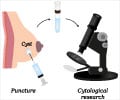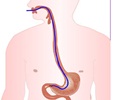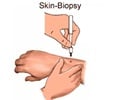A team of experts have framed new clinical guidelines that would go a long way towards undergoing needless thyroid biopsies,thus curbing the problem.

‘Each choice is a point value, ranging from 0 to 3 points. "Wider-than-tall," for example, is 0 points, and "taller-than-wide" is 3 points.’





Tessler and a national committee of experts published guidelines for an ultrasound-based risk stratification system to identify nodules that warrant biopsy or sonographic follow-up. The guidelines, they write, are "designed to identify most clinically significant malignancies while reducing the number of biopsies performed on benign nodules." "This potentially will have a big public health effect," said Tessler.Their Thyroid Imaging, Reporting and Data System or TI-RADS is modelled after the American College of Radiology's BI-RADS, a widely accepted risk stratification system for breast lesions.
The experts sought guidelines that are 1) founded on ultrasound features defined in their previously published lexicon;
2) easy to apply across a wide gamut of ultrasound practices
3) able to classify all thyroid nodules
Advertisement
But "the plethora, complexity and lack of congruence of these systems has limited their adoption by the ultrasound community and inspired our effort to publish a classification system under the auspices of the American College of Radiology," Tessler and colleagues wrote.
Advertisement
As the authors explained, "Points are given for all the ultrasound features in a nodule, with more suspicious features being awarded additional points.When assessing a nodule, the reader selects one feature from each of the first four categories and all the features that apply from the final category and sums the points. The point total determines the nodule's ACR TI-RADS level, which ranges from TR1, benign, to TR5, high suspicion of malignancy."
If the sum is 0 points, the nodule is TR1 and the guidelines recommend no fine-needle aspiration or follow-up. If the sum is 2 points, the nodule is TR2, or "not suspicious," and the guidelines recommend no fine-needle aspiration or follow-up. A sum of 3 points is TR3, or "mildly suspicious." For these nodules, the guidelines recommend fine-needle aspiration if the nodule is 2.5 centimeters or greater, or about 1 inch or more, and they recommend follow-ups with subsequent ultrasounds if it is 1.5 centimeters or greater.
TR4 nodules, or "moderately suspicious," are 4 to 6 points, and TR5 nodules, or "highly suspicious," are 7 points or more. For TR4 nodules, the guidelines recommend fine-needle aspiration if the nodule is 1.5 centimeters or greater and follow-ups if it is 1 centimeter or greater. For TR5 nodules, the guidelines recommend fine-needle aspiration if the nodule is 1 centimeter or greater and follow-ups if it is 0.5 centimeters or greater.
The guidelines recommend limiting fine-needle aspiration to two nodules per patient because biopsy of three or more nodules is poorly tolerated by patients, and the third biopsy increases cost with little added benefit and some additional risk. The guidelines also suggest appropriate timing for follow-up sonograms. "The ACR TI-RADS is designed to balance the benefit of identifying clinically important cancers against the risk and cost of subjecting patients with benign nodules or indolent cancers to biopsy and treatment," the authors wrote.
"Our recommendations for follow-up ultrasound substantially mitigate the possibility that significant malignancies will remain undetected over time and are concordant with the increasing trend toward active surveillance, or 'watchful waiting,' for low-risk thyroid cancer." The guidelines are published in Journal of the American College of Radiology.
Source-ANI















